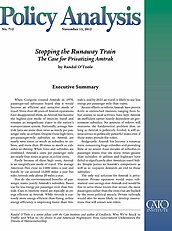Partly because of these high costs, Amtrak is an insignificant mode of travel. The average American flies close to 2,000 miles a year and travels by car around 15,000 miles a year but rides Amtrak only about 20 miles a year.
Nor do the environmental benefits of passenger trains justify Amtrak’s subsidies. Buses use far less energy per passenger mile than Amtrak. Cars in intercity travel are typically as energy efficient as Amtrak. While Amtrak is currently more energy efficient than flying, airline energy efficiency is improving faster than Amtrak’s, and by 2025 air travel is likely to use less energy per passenger mile than trains.
Recent efforts to reform Amtrak have proven futile as entrenched interests, ranging from labor unions to local activists, have kept Amtrak an inefficient carrier heavily dependent on government subsidies. No amount of reform will overcome the fundamental problem that, so long as Amtrak is politically funded, it will extend service to politically powerful states even if those states provide few riders.
Budgetarily, Amtrak has become a runaway train, consuming huge subsidies and providing little or no return. Four decades of subsidies to passenger trains that are many times greater than subsidies to airlines and highways have failed to significantly alter American travel habits. Simple justice to Amtrak’s competitors as well as to taxpayers demands an end to those subsidies.
The only real solution for Amtrak is privatization. Private operators would enjoy substantial cost savings over Amtrak and would be free to serve those routes that attract the most passengers rather than the ones that are backed by the most political muscle. Private railroads would also be more likely to develop innovations that will attract new riders.


